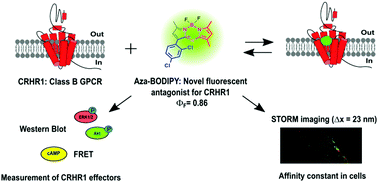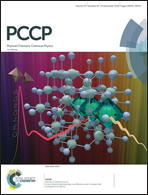A fluorescence nanoscopy marker for corticotropin-releasing hormone type 1 receptor: computer design, synthesis, signaling effects, super-resolved fluorescence imaging, and in situ affinity constant in cells†
Abstract
Class B G protein-coupled receptors (GPCRs) are involved in a variety of human pathophysiological states. These groups of membrane receptors are less studied than class A GPCRs due to the lack of structural information, delayed small molecule drug discovery, and scarce fluorescence detection tools available. The class B corticotropin-releasing hormone type 1 receptor (CRHR1) is a key player in the stress response whose dysregulation is critically involved in stress-related disorders: psychiatric conditions (i.e. depression, anxiety, and addictions), neuroendocrinological alterations, and neurodegenerative diseases. Here, we present a strategy to label GPCRs with a small fluorescent antagonist that permits the observation of the receptor in live cells through stochastic optical reconstruction microscopy (STORM) with 23 nm resolution. The marker, an aza-BODIPY derivative, was designed based on computational docking studies, then synthesized, and finally tested in biological cells. Experiments on hippocampal neurons demonstrate antagonist effects in similar concentrations as the well-established antagonist CP-376395. A quantitative analysis of two color STORM images enabled the determination of the binding affinity of the new marker in the cellular environment.



 Please wait while we load your content...
Please wait while we load your content...